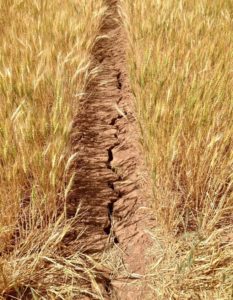Sushil Thapa1, Jourdan Bell2, Qingwu Xue1, and Jackie Rudd2
Texas A&M AgriLife Research1 and Extension2 at Amarillo
Winter wheat is a major crop for grain and forage production and is managed under both dryland and irrigated conditions in the U.S. Southern High Plains. Wheat yield and water-use efficiency (the ratio of yield to evapotranspiration, ET) in the area are primarily limited by soil water deficit from late spring to early summer. Therefore, the effective use of soil water, which is from soil water storage at planting as well as precipitation during the growing season, is very important to achieve yield potential. Adoption of drought-tolerant cultivars is another significant strategy and knowing the cultivar differences in soil water extraction and use during the growing season can be important for wheat management.
In 2010, we started a long-term field study with the objective of characterizing the differences in winter wheat cultivars in terms of soil water extraction and use, aboveground biomass, and grain yield under dryland conditions. Every year, we grow 20 cultivars that well adapted to the High Plains region, including a historic check. In particular, we have measured the soil water dynamics of Texas A&M AgriLife Research developed (TAM) wheat cultivars under dryland conditions.
Our results showed that improved TAM cultivars (for example the top-growing cultivars TAM 111 and TAM 112) are able to extract more water from deeper depths particularly between jointing and maturity. The 2017-2018 was a very dry wheat production season across the Texas High Plains. In this season, the improved cultivar TAM 112 yielded 31% more than a relatively older cultivar (TAM 105). Soil water extraction from the deeper soil profile was found synchronous with better performance of winter wheat in the improved cultivar under dryland. Our other field and greenhouse studies also showed that TAM 112 under dryland and TAM 111 under limited irrigation condition are more productive than many other cultivars. Consequently, TAM 111 and TAM 112 were the leading cultivars planted in Southern Great Plains for many years. The Texas A&M wheat breeding program continues its breeding efforts to improve cultivar productivity and disease package using TAM 111 and TAM 112 as foundational germplasm. TAM 204 is an awnless grain and grazing variety that was developed from TAM 112 and released in 2014. TAM 115 is a new 2019 release for grazing and grain production that was also developed from TAM 112. It is recommended that producers select newly developed cultivars that are adapted to the local climatic conditions for better utilization of soil water and increasing yield under the drought condition.
Fig. 1 Dryland wheat at late grain filling in Bushland, TX in 2018
Fig. 2. Soil water extraction from planting to maturity in four TAM cultivars under dryland in 2018. Note: the total rainfall during the growing season was only 0.9 inch (23 mm).

